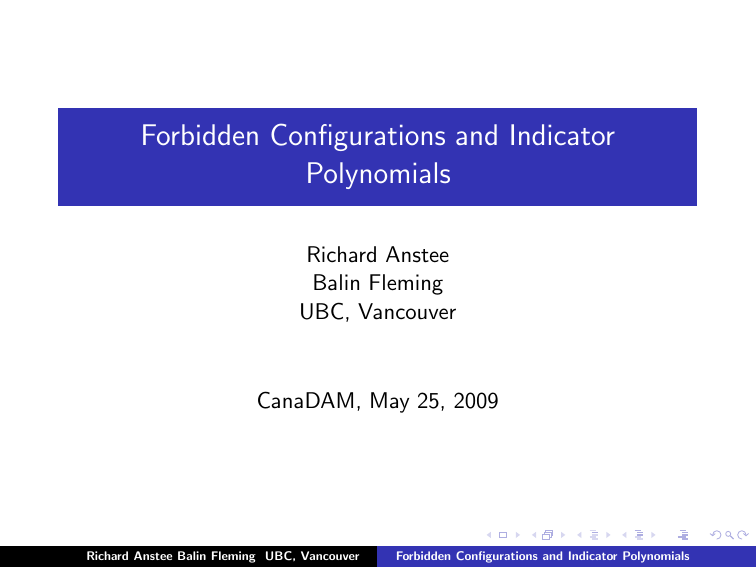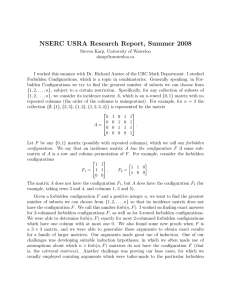Forbidden Configurations and Indicator Polynomials Richard Anstee Balin Fleming
advertisement

Forbidden Configurations and Indicator
Polynomials
Richard Anstee
Balin Fleming
UBC, Vancouver
CanaDAM, May 25, 2009
Richard Anstee Balin Fleming UBC, Vancouver
Forbidden Configurations and Indicator Polynomials
Introduction
The use of indicator polynomials was explored in a joint paper with
Fleming, Füredi and Sali. This talk focuses on joint work with
Balin Fleming that led to a new bound for Forbidden
Configurations. Füredi and Sali continue to explore applications to
critical hypergraphs.
Forbidden Configuration Survey at www.math.ubc.ca/∼anstee
Richard Anstee Balin Fleming UBC, Vancouver
Forbidden Configurations and Indicator Polynomials
[m] = {1, 2, . . . , m}
Let S be a finite set.
2S = {T : T ⊆ S}
S
S
k = {T ∈ 2 : |T | = k}
Definition We say that a matrix A is simple if it is a (0,1)-matrix
with no repeated columns.
Richard Anstee Balin Fleming UBC, Vancouver
Forbidden Configurations and Indicator Polynomials
[m] = {1, 2, . . . , m}
Let S be a finite set.
2S = {T : T ⊆ S}
S
S
k = {T ∈ 2 : |T | = k}
Definition We say that a matrix A is simple if it is a (0,1)-matrix
with no repeated columns.
i.e. if A is an m-rowed simple matrix then A is the incidence
matrix of some F ⊆ 2[m] .
Richard Anstee Balin Fleming UBC, Vancouver
Forbidden Configurations and Indicator Polynomials
Definition Given a matrix F , we say that A has F as a
configuration if there is a submatrix of A which is a row and
column permutation of F .
1 1 1 1 1 1
0 0 0 0 1 1
1 1 1 0
∈ A=
F =
0 1 0 1 0 1
1 0 0 0
1 0 0 1 1 1
Richard Anstee Balin Fleming UBC, Vancouver
Forbidden Configurations and Indicator Polynomials
Definition Given a matrix F , we say that A has F as a
configuration if there is a submatrix of A which is a row and
column permutation of F .
1 1 1 1 1 1
0 0 0 0 1 1
1 1 1 0
∈ A=
F =
0 1 0 1 0 1
1 0 0 0
1 0 0 1 1 1
We consider the property of forbidding a configuration F in A for
which we say F is a forbidden configuration in A.
Definition Let forb(m, F ) be the largest function of m and F so
that there exist a m × forb(m, F ) simple matrix with no
configuration F . Thus if A is any m × (forb(m, F ) + 1) simple
matrix then A contains F as a configuration.
Richard Anstee Balin Fleming UBC, Vancouver
Forbidden Configurations and Indicator Polynomials
Definition Let Kk denote the k × 2k simple matrix of all possible
columns on k rows (i.e. incidence matrix of 2 [k] ).
Theorem (Sauer 72, Perles and Shelah 72, Vapnik and
Chervonenkis 71)
m
m
m
forb(m, Kk ) =
+
+ ···
= Θ(mk−1 )
k −1
k −2
0
Richard Anstee Balin Fleming UBC, Vancouver
Forbidden Configurations and Indicator Polynomials
Definition Let Kk denote the k × 2k simple matrix of all possible
columns on k rows (i.e. incidence matrix of 2 [k] ).
Theorem (Sauer 72, Perles and Shelah 72, Vapnik and
Chervonenkis 71)
m
m
m
forb(m, Kk ) =
+
+ ···
= Θ(mk−1 )
k −1
k −2
0
Theorem (Füredi 83). Let F be a k × l matrix. Then
forb(m, F ) = O(m k )
Richard Anstee Balin Fleming UBC, Vancouver
Forbidden Configurations and Indicator Polynomials
Definition Let Kk denote the k × 2k simple matrix of all possible
columns on k rows (i.e. incidence matrix of 2 [k] ).
Theorem (Sauer 72, Perles and Shelah 72, Vapnik and
Chervonenkis 71)
m
m
m
forb(m, Kk ) =
+
+ ···
= Θ(mk−1 )
k −1
k −2
0
Theorem (Füredi 83). Let F be a k × l matrix. Then
forb(m, F ) = O(m k )
Which F have forb(m, F ) being O(m k−1 ) and which F have
forb(m, F ) being Θ(m k )?
Richard Anstee Balin Fleming UBC, Vancouver
Forbidden Configurations and Indicator Polynomials
Let A be an m-rowed simple matrix which has no configuration K k .
For any k-set of rows S ∈ [m]
let A|S denote the submatrix of A
k
given by the rows of S.
of rows we have
Since A has no Kk , then for every k-set S ∈ [m]
k
that A|S has an absent k × 1 (0,1)-column.
Remark If A is an m-rowed simple
matrix with the property that
the submatrix A|S has an absent
for every k-set of rows S ∈ [m]
k
column, then A has no Kk and so has at most O(m k−1 ) columns.
Richard Anstee Balin Fleming UBC, Vancouver
Forbidden Configurations and Indicator Polynomials
Let B be a k × (k + 1) simple matrix with one column of each
column sum. For k = 3 a possible B is
0 0 0 1
B = 0 0 1 1
0 1 1 1
For a matrix C , let t · C denote the matrix [CCC · · · C ] from
concatenating t copies of C . Let FB (t) = [Kk t · [Kk \B]] so for
our choice of B,
0 0 0 0 1 1 1 1
0 1 1 1
FB (t) = 0 0 1 1 0 0 1 1 t · 1 0 0 1
0 1 0 1 0 1 0 1
0 0 1 0
Let t be given. Let A be any m-rowed simple matrix which
has no
[m]
configuration FB (t). Then for any 3-set of rows S ∈ 3 , either
A|S has an absent column
or A|S has two columns which appear at most t times each.
Richard Anstee Balin Fleming UBC, Vancouver
Forbidden Configurations and Indicator Polynomials
Let B be a k × (k + 1) simple matrix with one column of each
column sum. For k = 3 a possible B is
0 0 0 1
B = 0 0 1 1
0 1 1 1
For a matrix C , let t · C denote the matrix [CCC · · · C ] from
concatenating t copies of C . Let FB (t) = [Kk t · [Kk \B]] so for
our choice of B,
0 0 0 0 1 1 1 1
0 1 1 1
FB (t) = 0 0 1 1 0 0 1 1 t · 1 0 0 1
0 1 0 1 0 1 0 1
0 0 1 0
Let t be given. Let A be any m-rowed simple matrix which
has no
[m]
configuration FB (t). Then for any 3-set of rows S ∈ 3 , either
A|S has an absent column
or A|S has two columns which appear at most t times each.
Richard Anstee Balin Fleming UBC, Vancouver
Forbidden Configurations and Indicator Polynomials
Let B be a k × (k + 1) simple matrix with one column of each
column sum. For k = 3 a possible B is
0 0 0 1
B = 0 0 1 1
0 1 1 1
For a matrix C , let t · C denote the matrix [CCC · · · C ] from
concatenating t copies of C . Let FB (t) = [Kk t · [Kk \B]] so for
our choice of B,
0 0 0 0 1 1 1 1
0 1 1 1
FB (t) = 0 0 1 1 0 0 1 1 t · 1 0 0 1
0 1 0 1 0 1 0 1
0 0 1 0
Let t be given. Let A be any m-rowed simple matrix which
has no
[m]
configuration FB (t). Then for any 3-set of rows S ∈ 3 , either
A|S has an absent column
or A|S has two columns which appear at most t times each.
Richard Anstee Balin Fleming UBC, Vancouver
Forbidden Configurations and Indicator Polynomials
Assume A is an m-rowed simple matrix with no F B (t).
Let S be a 3-set of rows in [m] and let α be a 3 × 1 column.
We say that an m × 1 column γ violates S (for the chosen α) if
γ|S = α.
We say 3 × 1 column α is
in short supply in A if it is violated by at most t columns of A.
Richard Anstee Balin Fleming UBC, Vancouver
Forbidden Configurations and Indicator Polynomials
Assume A is an m-rowed simple matrix with no F B (t).
Let S be a 3-set of rows in [m] and let α be a 3 × 1 column.
We say that an m × 1 column γ violates S (for the chosen α) if
γ|S = α.
We say 3 × 1 column α is
in short supply in A if it is violated by at most t columns of A.
Let T be the set of 3-sets S for which there is no absent column
and hence (at least) two 3 × 1 columns α, β in short supply. Then
by eliminating ≤ t|T | columns with violations on S ∈ T from A,
we obtain a matrix which has an absent column on each 3-set of
rows and so has O(m 2 ) columns. Unfortunately |T | can be as big
as Θ(m3 ).
Richard Anstee Balin Fleming UBC, Vancouver
Forbidden Configurations and Indicator Polynomials
Multilinear Indicator Polynomials
Let S = {i, j, k} ⊆ [m]
Let x1 , x2 , . . . , xm be variables. Let α = (α1 , α2 , α3 )T be a 3 × 1
(0,1)-column.
fS,α (x) = (xi − α¯1 )(xj − α¯2 )(xk − α¯3 )
Richard Anstee Balin Fleming UBC, Vancouver
Forbidden Configurations and Indicator Polynomials
Multilinear Indicator Polynomials
Let S = {i, j, k} ⊆ [m]
Let x1 , x2 , . . . , xm be variables. Let α = (α1 , α2 , α3 )T be a 3 × 1
(0,1)-column.
fS,α (x) = (xi − α¯1 )(xj − α¯2 )(xk − α¯3 )
For a m × 1 (0,1)-column γ
6= 0
fS,α (γ)
=0
Richard Anstee Balin Fleming UBC, Vancouver
if γ|S = α
otherwise
Forbidden Configurations and Indicator Polynomials
Multilinear Indicator Polynomials
fS,α (x) = (xi − α¯1 )(xj − α¯2 )(xk − α¯3 )
We check that degree of fS,α (x) is 3 with leading term
xi xj xk
Richard Anstee Balin Fleming UBC, Vancouver
Forbidden Configurations and Indicator Polynomials
Assume S ∈ T and there are two 3 × 1 columns α, β in short
supply (no column absent) and the two indicator polynomials are
fS,α , fS,β . We set
fS (x) = a1 fS,α (x) + a2 fS,β (x)
a1 = +1,
a2 = −1
We have that for a m × 1 (0,1)-column γ
6= 0 if γ|S = α or γ|S = β
fS (γ)
=0
otherwise
and degree of fS (x) is (at most) 2 since the leading terms of
degree 3 of fS,α (x) and fS,β (x) will cancel.
Richard Anstee Balin Fleming UBC, Vancouver
Forbidden Configurations and Indicator Polynomials
Let T be the set of all 3-tuples S for which two columns, say α, β
are in short supply.
A greedy approach would yield what we call a maximal
independent set I = (Si ) which is an ordered list S1 , S2 , . . . ∈ T
and m × 1 (0,1)-columns γ1 , γ2 , . . . of A so that
Richard Anstee Balin Fleming UBC, Vancouver
Forbidden Configurations and Indicator Polynomials
Let T be the set of all 3-tuples S for which two columns, say α, β
are in short supply.
A greedy approach would yield what we call a maximal
independent set I = (Si ) which is an ordered list S1 , S2 , . . . ∈ T
and m × 1 (0,1)-columns γ1 , γ2 , . . . of A so that
γi violates Si for one of the two chosen columns
but violates no Sj with j < i.
Richard Anstee Balin Fleming UBC, Vancouver
Forbidden Configurations and Indicator Polynomials
Let T be the set of all 3-tuples S for which two columns, say α, β
are in short supply.
A greedy approach would yield what we call a maximal
independent set I = (Si ) which is an ordered list S1 , S2 , . . . ∈ T
and m × 1 (0,1)-columns γ1 , γ2 , . . . of A so that
γi violates Si for one of the two chosen columns
but violates no Sj with j < i.
We could then delete ≤ 2t|I| columns from A to obtain a matrix
with at least one column absent on each triple of rows.
Richard Anstee Balin Fleming UBC, Vancouver
Forbidden Configurations and Indicator Polynomials
Let T be the set of all 3-tuples S for which two columns, say α, β
are in short supply.
A greedy approach would yield what we call a maximal
independent set I = (Si ) which is an ordered list S1 , S2 , . . . ∈ T
and m × 1 (0,1)-columns γ1 , γ2 , . . . of A so that
γi violates Si for one of the two chosen columns
but violates no Sj with j < i.
We could then delete ≤ 2t|I| columns from A to obtain a matrix
with at least one column absent on each triple of rows.
Theorem If I = (Si ) is an independent set, then the indicator
polynomials fS are linearly independent.
Richard Anstee Balin Fleming UBC, Vancouver
Forbidden Configurations and Indicator Polynomials
Theorem If I = (Si ) is an independent set, and the indicator
polynomials fS are degree at most 2 then
m
m
m
|I| ≤
+
+
2
1
0
= Θ(m2 ).
Richard Anstee Balin Fleming UBC, Vancouver
Forbidden Configurations and Indicator Polynomials
Theorem forb(m, FB (t)) is Θ(m 2 ).
Proof: Assume A is a matrix with no FB (t). Let I = (Si ) be a
maximal independent set with indicator polynomials f Si . For a
given set S ∈ I there are at most 2t columns with violations of the
two chosen columns in short supply on S. By our linear algebra,
|I| is O(m 2 ). Thus we may remove 2t|I| or O(m 2 ) columns and
remove all violations on the two chosen 3 × 1 columns for each
S ∈ I and so on each S ∈ T there will be an absent 3 × 1 column.
The resulting matrix has at most O(m 2 ) columns and so A has at
most O(m2 ) columns.
Richard Anstee Balin Fleming UBC, Vancouver
Forbidden Configurations and Indicator Polynomials
We have one more 3-rowed configuration F with forb(m, F ) being
O(m2 ). Let D be the 3 × 5 simple matrix with all columns of sum
at least 1 that do not simultaneously have 1’s in rows 1 and 2. We
take FD (t) = [03 (t + 1) · D] which becomes
0
0 1 1 0 0
FD (t) = 0 (t + 1) · 0 0 0 1 1
0
1 0 1 0 1
If a matrix A has no FD (t) then each 3-set of rows {i, j, k} in
some ordering has one of the following occur:
i
j
k
no
≤t
0
0
or at least two columns are in short supply or
.
0
0
0
1
Richard Anstee Balin Fleming UBC, Vancouver
Forbidden Configurations and Indicator Polynomials
We have one more 3-rowed configuration F with forb(m, F ) being
O(m2 ). Let D be the 3 × 5 simple matrix with all columns of sum
at least 1 that do not simultaneously have 1’s in rows 1 and 2. We
take FD (t) = [03 (t + 1) · D] which becomes
0
0 1 1 0 0
FD (t) = 0 (t + 1) · 0 0 0 1 1
0
1 0 1 0 1
If a matrix A has no FD (t) then each 3-set of rows {i, j, k} in
some ordering has one of the following occur:
i
j
k
no
≤t
0
0
or at least two columns are in short supply or
.
0
0
0
1
Richard Anstee Balin Fleming UBC, Vancouver
Forbidden Configurations and Indicator Polynomials
We have one more 3-rowed configuration F with forb(m, F ) being
O(m2 ). Let D be the 3 × 5 simple matrix with all columns of sum
at least 1 that do not simultaneously have 1’s in rows 1 and 2. We
take FD (t) = [03 (t + 1) · D] which becomes
0
0 1 1 0 0
FD (t) = 0 (t + 1) · 0 0 0 1 1
0
1 0 1 0 1
If a matrix A has no FD (t) then each 3-set of rows {i, j, k} in
some ordering has one of the following occur:
i
j
k
no
≤t
0
0
or at least two columns are in short supply or
.
0
0
0
1
Richard Anstee Balin Fleming UBC, Vancouver
Forbidden Configurations and Indicator Polynomials
We have one more 3-rowed configuration F with forb(m, F ) being
O(m2 ). Let D be the 3 × 5 simple matrix with all columns of sum
at least 1 that do not simultaneously have 1’s in rows 1 and 2. We
take FD (t) = [03 (t + 1) · D] which becomes
0
0 1 1 0 0
FD (t) = 0 (t + 1) · 0 0 0 1 1
0
1 0 1 0 1
If a matrix A has no FD (t) then each 3-set of rows {i, j, k} in
some ordering has one of the following occur:
i
j
k
no
≤t
0
0
or at least two columns are in short supply or
.
0
0
0
1
Richard Anstee Balin Fleming UBC, Vancouver
Forbidden Configurations and Indicator Polynomials
The case of one column in short supply (but not absent) makes the
proof much more difficult. We can eliminate O(m 2 ) columns and
make a column absent on each 3-set of rows but the argument is
more complex. The new proof idea, using indicator polynomials,
was to consider what is in short supply on some 4-sets of rows and
miraculously we are able to find indicator polynomials of degree 2
(we are able to cancel the terms of degree 4 and 3).
Richard Anstee Balin Fleming UBC, Vancouver
Forbidden Configurations and Indicator Polynomials
A typical situation if we avoid FD (t) could be:
i
j
k
l
Note that
i
j
k
l
≤ t ≤ t ≤ t ≤ t no
0
0
1
0
0
0
0
1
0
1
0
1
1
1
0
≤t
1
⇒
0
1
i
j
k
l
≤t ≤t
1
1
1
0
0
0
1
1
We only need a few of these 4 × 1 columns to get our reduction in
degree.
Richard Anstee Balin Fleming UBC, Vancouver
Forbidden Configurations and Indicator Polynomials
i
j
k
l
+1 −1 +1 −1
0
1
1
0
0
0
0
0
0
0
0
0
1
1
0
0
α
β
γ
δ
We form a new indicator polynomial for the 4 columns α, β, γ, δ
above as
fS (x) = +1fS,α (x)−1fS,β (x)+1fS,γ (x)−1fS,δ (x)
and we find that fS is a degree 2 indicator polynomial for the 4
columns above.
Richard Anstee Balin Fleming UBC, Vancouver
Forbidden Configurations and Indicator Polynomials
Theorem Let k, t be given positive integers with k ≥ 2, t ≥ 1.
Let B as a k × (k + 1) simple matrix with one column of each
column sum And let FB (t) = [Kk t · [Kk \B]]. Then
forb(m, FB (t)) is Θ(m k−1 )
Let D be the k × (2k − 2k−2 − 1) simple matrix with all columns
of sum at least 1 that do not simultaneously have 1’s in rows 1 and
2. We take FD (t) = [0k (t + 1) · D] Then
forb(m, FD (t)) is Θ(m k−1 )
Richard Anstee Balin Fleming UBC, Vancouver
Forbidden Configurations and Indicator Polynomials
Theorem Let k, t be given positive integers with k ≥ 2, t ≥ 1.
Let B as a k × (k + 1) simple matrix with one column of each
column sum And let FB (t) = [Kk t · [Kk \B]]. Then
forb(m, FB (t)) is Θ(m k−1 )
Let D be the k × (2k − 2k−2 − 1) simple matrix with all columns
of sum at least 1 that do not simultaneously have 1’s in rows 1 and
2. We take FD (t) = [0k (t + 1) · D] Then
forb(m, FD (t)) is Θ(m k−1 )
Theorem Let F is a k-rowed configuration which is not a
configuration in FB (t) (for any choice of B as a k × (k + 1) simple
matrix with one column of each column sum and for any t) and
not in FD (t) (for any t). Then forb(m, F ) is Θ(m k ).
Richard Anstee Balin Fleming UBC, Vancouver
Forbidden Configurations and Indicator Polynomials
Merci/Thanks to the organizers for arranging this conference!
Richard Anstee Balin Fleming UBC, Vancouver
Forbidden Configurations and Indicator Polynomials






